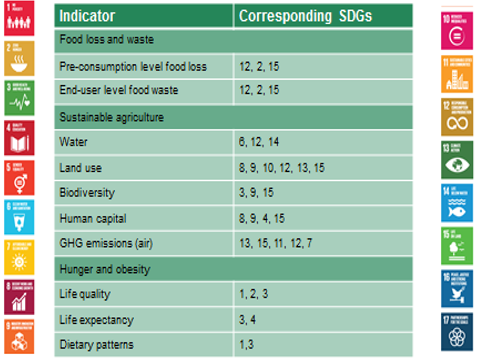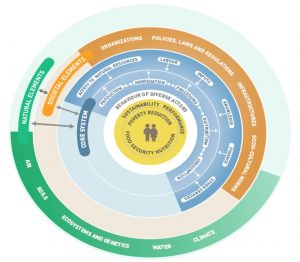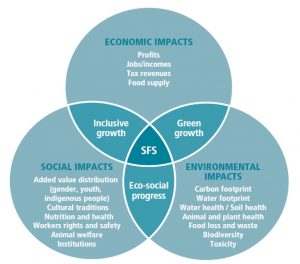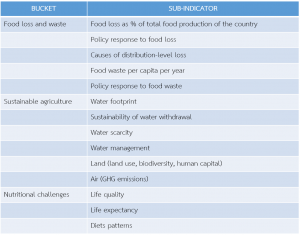Sustainable Food Systems (SFS)
Food systems (FS) include all stakeholders and activities linked to creating added value involved in the cultivation, gathering, processing, distribution, consumption, and disposal of food products that derived from agriculture, forestry or fisheries, and parts of the socioeconomic and natural environment related to the food system.
The food system consists of sub-systems, such as agricultural system, waste management system, and inputs system, etc., and their interactions with other vital systems, such as energy system, trade system, and health system, etc. Therefore, a structural change in the food system may arise from changes in other systems; for example, a policy promoting more biofuel in the energy system will have a significant impact on the food system.
A sustainable food system (SFS) is a food system that provides food security and nutrition to everyone in economic, social, and environmental dimensions to create food security and nutrition for future generations that are profitable (economic sustainability), has broad benefits to the society (social sustainability) and a positive or neutral impact on the natural environment (environmental sustainability).
Sustainable food systems are at the heart of the United Nation’s Sustainable Development Goals (SDGs), which was adopted in 2015. The SDGs call for major transformations in agriculture and food systems to end hunger, achieve food security, and improve nutrition by 2030. The global food system, therefore, needs to be transformed to be more productive, more inclusive of poor and marginalized populations, sustainable environment, and able to deliver healthy and nutritious diets to all. These transformations are complex and challenging since they require a combination of interconnected actions at the local, national, regional, and global levels.
Food Systems today are not sustainable
Food production is a resource-intensive activity, which has a huge impact on the environment and uses significant amount of natural resources, such as water and energy, resulting in the loss of biodiversity and climate change. It also contributes to 21-37% of greenhouse gas emissions (Mbow et al.,2019). However, achieving safe and nutritious food remains a problem for the population of all countries. Obesity and diabetes show unhealthy foods and poor dietary choices, signifying a major public health problem in many countries and creating negative impacts on the economy.
Important consideration to achieve a sustainable food system
There are many policies related to a sustainable food system, as follows.
- Promoting sustainable approaches determinedly or expanding the dimension of an ecosystem by increasing or maintaining productivity and efficiency, as well as reducing the environmental burden (biodiversity, soil, water, and air).
- Reducing food loss and food waste, as well as promoting the reuse and recycle of the inevitable food waste.
- Encouraging dietary changes that are healthier and less resource-intensive, such as plant foods.
- Improving the flexibility and rigidity of the food system, especially diversification to cope with the lifting of geopolitical development and adapting to the impacts of climate change.
- Increasing the responsibility and stewardship of producers and consumers on the environmental, economic, social, and public health impacts of food systems through the development and monitoring of policies, as well as increasing transparency, education, training, and label improvement to inform options for consumers.
Food System Wheel
The main goals of the FAQ food system wheel consist of poverty reduction and food security and nutrition under the three dimensions of sustainability competency (economic, social, and environmental framework). These competencies are determined by the behavior of those involved or stakeholders in the food system (people-centered). This operation also takes place in a structural system, which consists of the main system: social component and natural elements. The main system consists of the level of activity that follows the flow of food products (production, collection, processing, distribution, consumption, and waste disposal) and the level of support services. The social component consists of organizational policies, applicable laws and regulations, socio-cultural norms, and infrastructure, and the natural elements consist of water, soil, climate, ecosystems, and genetics.
Sustainability in the food system
The development of a sustainable food system, requires a holistic sustainability audit and a good sustainable food system must create positive value in all three dimensions, namely,
- The economic dimension: a food system is considered sustainable if the activities performed by each food system stakeholders or support providers are commercially or fiscally viable. The activities should generate benefits or economic added value for all categories of stakeholders, such as wages for workers, taxes for governments, profits for enterprises, and food supply improvements for consumers.
- The social dimension: a food system is considered sustainable when there is an equity in the distribution of the economic value-added when considering vulnerable groups categorized by gender, age, race, etc. The basic principles are food system activities that need to contribute to the advancement of important socio-cultural outcomes, such as nutrition and health, traditions, labor conditions, and animal welfare.
- The environmental dimension: the sustainability is determined by ensuring that the impacts of food system activities on the surrounding natural environment are neutral or positive by considering the biodiversity, water, soil, animal and plant health, carbon and water footprint, food loss and food waste, and toxicity.
SDGs and Food Sustainability Index

Source: Economist Intelligence Unit และ Barilla Center for Food & Nutrition
Food Sustainable Development Index created by Economist Intelligence Unit and Barilla Center for Food & Nutrition as a tool designed to highlight international policies and good practices related to global conflicts and SDGs for food, climate change, sustainable cities, production and consumption, health, gender equality, education, and infrastructure.
The country’s ranking index for sustainable food systems holds on to three principles, which are food loss and food waste, sustainable agriculture, and nutritional challenges; all of which can be analyzed for the sustainability by assessing 58 different indicators.
Food Sustainability Index 2018
The overall score for the food sustainable development index was calculated from the weighted average of the three scores, which are food loss and food waste, sustainable agriculture, and nutritional challenges. A high score implies that the country is on the right track leading to a sustainable food and nutrition system as there are inherent differences in food systems and agriculture, production assessment, food and nutrition issues, and the development of cross-country policies and operations with different income levels. Therefore, the overall world ranking assessment should be performed with caution.
- Food Loss and Food Waste Score is a weighted average of policy indicators to respond to food loss and food waste. A high score indicates that the country is on the right track in dealing with food wastage and food waste.
- Sustainable Agriculture Score is a weighted average of the indicators in the water, land, emissions category, and land users. A high score indicates that the country is on the right track to implement a sustainable agricultural system.
- The Nutrition Challenge Score is a weighted average of a metric in the health and nutrition category. A high score indicates that the country is on the right track in solving nutrition problems.
Food sustainability Index (FSI) of Thailand
As of March 2021, the food sustainability index for Thailand could not be calculated because the required information is scattered over various agencies and is not readily accessible. Moreover, the existing data is still inconsistent with the calculation for the FSI indicators. Examples of the databases that could be used to compute the FSI indicators are as follows.
- Natural resource database by the Ministry of Natural Resources and Environment
- Databases for air quality and air pollution, and the amount of waste by the Pollution Control Department
- Water database for agriculture and water management by the Office of National Water Resources
- Agriculture database by the Ministry of Agriculture and Cooperatives
- Forest area database by the Royal Forest Department
- Fisheries database by the Department of Fisheries
Furthermore, there is also case studies of sustainable agriculture investigated by various universities and government research institutes, such as the sustainability assessment of sugarcane, cassava, and oil palm. These research results could also be used as a part of Thai’s FSI index development.
Further information, please contact:
Seksan Papong
Research Specialist
02 564 6500 ext. 4771
seksanp@mtec.or.th


Copyright © 2019 สถาบันเทคโนโลยีและสารสนเทศเพื่อการพัฒนาที่ยั่งยืน (สทย.) โดย ศูนย์เทคโนโลยีโลหะและวัสดุแห่งชาติ สำนักงานพัฒนาวิทยาศาสตร์และเทคโนโลยีแห่งชาติ

 th
th en
en




